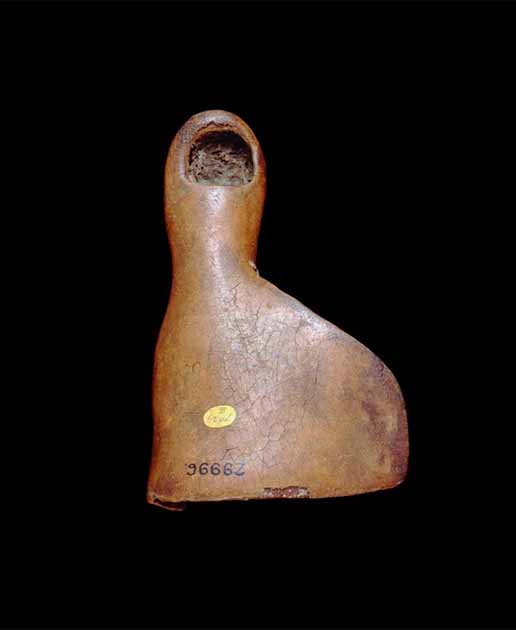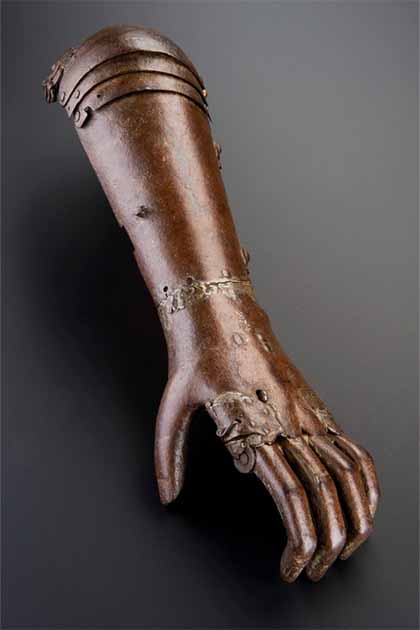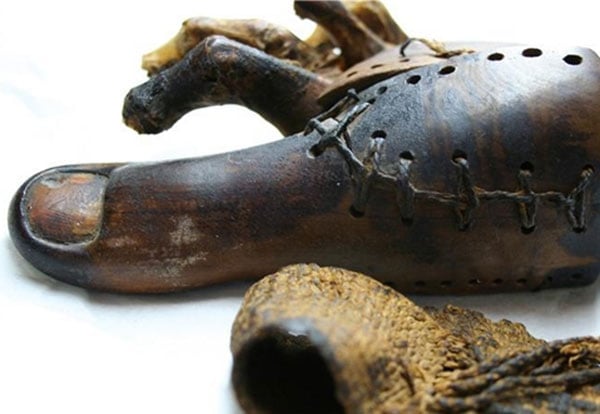3,000-Year-Old Artificial Toe Reveals Ancient Origins of Prosthetics
Believe it or not, but the use of prosthetics is actually not a modern phenomenon. In fact, the creation of man-made devices to replace missing body parts was already in use several thousand years ago. According to Dr. Jaqueline Finch, from the University of Manchester, the oldest known prosthesis actually dates back 3,000 years and came from ancient Egypt.
The Oldest Known Ancient Prosthesis Discovered in Egypt
In 2000, researchers Andreas Nerlich and colleagues from Ludwig-Maximilians University made a stunning discovery. Working in the Theban necropolis, they unearthed a prosthetic big toe made of wood and leather which was attached to the almost 3,000-year-old mummy of an Egyptian noblewoman.
- New Revelations When 3,000-Year-Old Prosthetic Toe is Examined with Cutting Edge Technology
- Like Something Out of The Walking Dead: Medieval Warrior Found with Knife Hand Prosthesis
Identified as Tabaketenmut, the woman is believed to have lived some time around 950 and 710 BC. Now housed at the Egyptian Museum in Cairo, the prosthetic toe was made of wood and leather. In their article published in Lancet, they described it as “possibly the oldest known intravital limb prosthesis.” But is it really?
The Tabaketenmut toe wasn’t the first ancient prosthetic toe to have been unearthed in Egypt. Visitors to the Egyptian Galleries at the British Museum in London get the chance to see the Greville Chester toe. Originally discovered in Thebes, the toe was made out of cartonnage, a blend of linen, animal glue and plaster which resembles papier mâché. Through analysis of the linen used it was dated to 600 BC.

The Greville Chester toe, discovered in Thebes and now housed at the British Museum. (British Museum / CC BY-NC-SA 4.0)
Did These Ancient Egyptian Prosthetics Have a Practical Function?
Ancient Egyptians perceived the afterlife as a perfect version of this life, making it important in their worldview for their body to be intact at the time of burial. In another Lancet article, Jaqueline Finch explained how “spells decorating the inside of coffins (the Coffin Texts, c. 2055 BC), and mortuary texts written on papyrus (the Book of the Dead, c. 1550 BC) all refer to the importance of “reassembling” and “reuniting” the body to enable “revitalization” to take place in the Afterlife.”
In line with a desire for corporal wholeness, embalmers would use anything from plaster, sawdust, mud, butter, sand or linen to fill in any “gaps” before burial. This evident due to the fact that a variety of prosthetic devices have been found on mummies. These were “generally poor imitations… of linen, reed, mud, and resin” and they include feet, legs, noses, and even penises. (Yep, the ancient Egyptians believed that procreation was an activity that was possible in the afterlife).

Wooden prosthetic hand from ancient Egypt. Model limbs were used during the embalming process to replace damaged or missing body parts, to ensure the body was complete for the afterlife. (Leeds Museums and Galleries / CC BY-NC-SA 3.0)
While this ideological belief may explain the presence of such prosthetic devices on mummies, some of the ancient Egyptian prosthetic devices may also have had a practical function. Research conducted by Finch at the Centre for Rehabilitation and Human Performance Research Gait Laboratory, at the University of Salford in the United Kingdom, used experimental archaeology, replicas of the original artifacts and two volunteers with similar amputations to proove that both of these ancient prosthetic toes were actually efficient for walking and had been used while their owners were still alive.
This cutting-edge research concluded that the use of the ancient prosthetic toes would have made walking around in ancient Egyptian sandals much easier. Thus, this device had a practical function, alongside a possible ideological purpose. It also led the researcher to conclude that prosthetic science was emerging hundreds of years earlier than previously thought, and that “attribution for the first glimmers of this branch of medicine should be firmly laid at the feet of the ancient Egyptians.”

Plaster copy of the Capua leg which dates back to about 300 BC and was excavated from a tomb near Capua. (Science Museum, London / CC BY 4.0)
Tangible Evidence of Ancient Prosthetics
The use of prosthetics demonstrates the resourcefulness of people in ancient times. While until recent times many prosthetic devices were made of basic materials, such as wood and metal, attached to the body with leather, this research shows that in the case of ancient Egypt their knowledge of anatomy and the functioning of the foot was actually pretty advanced.
These conclusions are only possible when tangible evidence of prosthetics is available. Other examples of ancient prosthetics include the Capua leg, which dates back to 300 BC, and is currently housed at the Science Museum in London. While it is actually a copy made of plaster (the original was destroyed in a 1941 bombing in London), the prosthetic leg was discovered in the burial of a wealthy Roman at Santa Maria di Capua Vetere.
Finch lists other examples of ancient prosthetics in her Lancet article, including an artificial foot buried with a man dating back to the 5th to 7th century AD and discovered in Bonaduz, Switzerland. There is also a foot made from wood and bronze discovered in a grave in Griesheim from some time around the 7th to 8th century AD.

The Iron Hand of Götz von Berlichingen. (Public domain)
Meanwhile, more modern examples exist such as the fully articulated left forearm and hand believed to have been created for the Germany knight Götz von Berlichingen who lost his arm at the Battle of Landshut in 1503. It is now on display at the Science Museum in London.
Nevertheless, in discussing examples of ancient prosthetics, Finch argues on the need to use gait analysis to confirm that they “can also rightly be considered a true prosthetic replacement,” due to the fact that “to be classed as true prosthetic devices any replacement must satisfy several criteria.” These criteria include being able to “withstand bodily forces,” that it have the correct proportions, that it be “easy to take on and off” and, of course, that “it must assist walking.”

Prosthetic arm dating to between about 1560 to 1600 from the Science Museum in London. (Wellcome Collection / CC BY 4.0)
Intangible Evidence of Ancient Prosthetics
Throughout the annals of history, there are some references to ancient prosthetics, or at least the concept. In the ancient Egyptian story of the Eye of Horus, the eye of the god Horus was destroyed by his rival Set, before being replaced by Thoth. History Today includes the story of the farmer Mindon, by the poet Erycius and the satirist Lucian, who both mention the use of prosthetic appendages after the loss of a body part, while Herodotus tells the tale of Hegesistratus of Elis who used a wooden prosthesis after cutting off his foot to escape from the Spartans.
The use of iron as a material for a prosthetic device, for instance, can be seen in Pliny’s account of the iron hand of Marcus Sergius Silus. According to Pliny, the Roman general lost his right hand during the Second Punic War and had a prosthetic arm made of iron that allowed him to hold his shield. This meant that he could return to the battlefield and continue fighting. Finch argues that these textual accounts are “fraught with problems” due to the fact that “such prostheses may be just complete fiction.”
Despite these early advances in prosthetics technology, there was not much development in this area in the millennia that followed. For instance, iron prosthetic arms and legs were still in use during the Middle Ages, which was more than a thousand years after Marcus Sergius. Apparently, it was the metalworkers who made armors for the knights that also crafted the prosthetic devices for their clients.
Interestingly, it has been claimed that the purpose of these devices were not so much practical as aesthetic. It seems that these artificial limbs were used to hide lost limbs, which were at the time considered to be an embarrassing deformity. Given that not much changed in the use of prosthetic devices from the Roman era till the Middle Ages, it is unsurprising that many of us assume that the use of such devices is a relatively recent phenomenon.

Robotic prosthetic arm. (Vladislav Ociacia / Adobe Stock)
The Use of Prosthetics Today
Three thousand years on, and prosthetic devices continue to be in use and are just as crucial for people with missing limbs now as they were to people thousands of years ago. Today's devices are much lighter, made of plastic, aluminum and composite materials to provide amputees with the most functional devices.
- 16th Century Prosthetic Iron Hand: The Story of Gotz von Berlichingen
- Chinese Man with Fused Knee used a Prosthetic Leg with a Horse Hoof Tip 2,200 Years Ago
In addition to lighter, patient-molded devices, the advent of microprocessors, computer chips and robotics in today's devices are designed to return amputees to the lifestyle they were accustomed to, rather than to simply provide basic functionality or a more pleasing appearance. Prostheses are more realistic with silicone covers and are able to mimic the function of a natural limb more now than at any time before.
Top image: A 3,000-year-old prosthetic big toe unearthed in Egypt. Source: Jacky Finch / University of Manchester
By Wu Mingren
References
Choi, C. Q. 27 July 2007. “World's First Prosthetic: Egyptian Mummy's Fake Toe” in Live Science. Available at: http://www.livescience.com/4555-world-prosthetic-egyptian-mummy-fake-toe.html
Clements, I. P., 2014. “How Prosthetic Limbs Work” in howstuffworks. Available at: http://science.howstuffworks.com/prosthetic-limb1.htm
Daley, J. 21 June 2017. “This 3,000-Year-Old Wooden Toe Shows Early Artistry of Prosthetics” in Smithsonian Magazine. Available at: https://www.smithsonianmag.com/smart-news/study-reveals-secrets-ancient-cairo-toe-180963783/
Draycott, J. 3 March 2019. “On A Limb: The classical world created a variety of means of mobility for the disabled – both mythical and real” in History Today. Available at: https://www.historytoday.com/archive/feature/limb
Finch, J. 12 February 2011. “The ancient origins of prosthetic medicine” in Lancet. Available at: https://doi.org/10.1016/S0140-6736(11)60190-6
Garber, M. 21 November 2013. “The Perfect, 3,000-Year-Old Toe: A Brief History of Prosthetic Limbs” in The Atlantic. Available at: https://www.theatlantic.com/technology/archive/2013/11/the-perfect-3-000-year-old-toe-a-brief-history-of-prosthetic-limbs/281653/
Nerlich, A. G. et al. 23 December 2000. “Ancient Egyptian prosthesis of the big toe” in Lancet. Available at: https://doi.org/10.1016/S0140-6736(00)03507-8
The University of Manchester. 2 October 2012. “Egyptian toes likely to be the world’s oldest prosthetics” in the University of Manchester. Available at: https://www.manchester.ac.uk/discover/news/egyptian-toes-likely-to-be-the-worlds-oldest-prosthetics/
Whitaker, B. 23 December 2000. “Artificial toe puts mummy in history books” in The Guardian. Available at: https://www.theguardian.com/world/2000/dec/23/brianwhitaker

















Comments
I myself lost half of my right thumb. It was at that time my Doctor Brian informed me I was lucky it was my thumb, and not my toe. I thought he was joking, because I use my hands to make a living and thought big deal if I just had to limp, my thumb is way more important. Brian was right. It seems your big toe is incredibly important for balance. In fact most do better with no foot, than a partial foot. But then he goes on to tell me about 'thoes'. It seems folks who do lose a big toe, often opt for removal of a thumb, only to attach it for a toe! I'm sittin there listening to him tell me about thoes, an I just felt blessed I was gonna walk outta there, and not come back to let him part me out !!! But it does make one curious as to when folks actually did start re-attaching parts. Can't help but think the ancients didn't at least try..
leave it to the Egyptians to make really awesome looking fake toes.
Peace and Love,
Ricky.